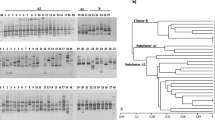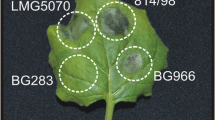Abstract
The relationships among strains of Pseudomonas syringae pv. glycinea (Psg) and Pseudomonas syringae pv. phaseolicola (Psp) isolated from kudzu ( Pueraria lobata) and bean ( Phaseolus vulgaris) were investigated. All strains tested showed a close phenotypic similarity, with the exception of the utilization of inositol and mannitol as well as the production of toxins. On this basis the strains could be divided into three groups. Group 1 consists of all strains of pathovar glycinea, group 2 includes all Psp strains isolated from kudzu, and all Psp strains isolated from bean belong to group 3. This grouping was also reflected in the genetic fingerprints using the polymerase chain reaction (PCR) with primers that anneal to dispersed repetitive bacterial sequences (rep-PCR). The rep-PCR generated fingerprints were unique for each of the three groups. The strains of group 2, Psp strains isolated from kudzu, possess certain characteristics of group 1 (ethylene production) and group 2 (phaseolotoxin production). The Psp strains from kudzu can be clearly differentiated from Psp strains isolated from bean. They utilize mannitol, produce ethylene, and are strongly pathogenic to kudzu, bean, and soybean. The results obtained show that the Psp strains from kudzu should be separated from the pathovar phaseolicola and should represent their own pathovar.
Similar content being viewed by others
References
Arndt H, Henning C, Völksch B and FritscheW(1989) Beziehungen zwischen Virulenz und Phaseolotoxinbildungsvermögen bei verschiedenen Pseudomonas syringae pv. phaseolicola-Stämmen. Arch. Phytopathol. Pflanzenschutz 25: 347-357
Bradbury JF (1988) Identification of cultivable bacteria from plants and plant tissue cultures by use of simple classical methods. Acta Horticulturae 225: 27-37
Dye DW (1968) A taxonomic study of the genus Erwinia. 1. The 'amylovora' group. N.Z.J. Science 11: 590-607
Gardan L, Shafik HL and Grimont PAD (1995) DNA relatedness among pathovars of P. syringae and related bacteria. 5th Int. Conf. on Pseudomonas syringae pathovars and related pathogens. Berlin, Germany, Book of abstracts, 42
Goto M and Hyodo H(1987) Ethylene production by cell-free extract of the kudzu strain of Pseudomonas syringae pv. phaseolicola. Plant Cell Physiol 28: 405-414
Guthke R, Nüske J, Schorcht R, Fritsche W and Knorre WA (1984) Dynamic model of discontinuous and continuous phaseolotoxin production of Pseudomonas syringae pv. phaseolicola. Z Allg Mikrobiol 24: 427-435
King EO, Ward MK and Raney DE (1954) Two simple media for the demonstration of pyocyanin and fluorescin. J Lab Clinical Medicine 44: 301-307
Lelliott RA, Billing E and Hayward AC (1966) A determinative scheme for the fluorescent plant pathogenic Pseudomonads. J Appl Bacteriol 29: 470-489
Louws FJ, Fulbright DW, Stephens CT and de Bruijn FJ (1994) Specific genomic fingerprints of phytopathogenic Xanthomonas and Pseudomonas pathovars and strains generated with repetitive sequences and PCR. Appl Environ Microbiol 60: 2286-2295
Patil SS, Kolattukudy PE and Dimond AE (1970) Inhibition of ornithine carbamyl transferase from bean plants by the toxin of Pseudomonas phaseolicola. Plant Physiol 46: 752-753
Takikawa Y, Ando Y, Hamaya E, Tsuyumu S and Goto M (1988) Identification of the pathogens responsible for bacteriosis of tea plant occurred in 1983. Ann Phytopath Soc Japan 54: 223-228
Umbarger HE (1978) Amino acid biosynthesis and its regulation. Annu Rev Biochem 47: 533-606
Versalovic J, Koeuth T and Lupski JR (1991) Distribution of repetitive DNA sequences in eubacteria and application to fingerprinting of bacterial genomes. Nucleic Acids Res 19: 6823-6831
Völksch B, Bublitz F and Fritsche W (1989) Coronatine production by Pseudomonas syringae pathovars: Screening method and capacity of product formation. J Basic Microbiol 29: 463-468
Völksch B, Laplace F and Fritsche W (1984) Untersuchungen zur Variabilität der Phaseolotoxinbildung bei Pseudomonas syringae pv. phaseolicola. Zbl Mikrobiol 139: 109-118
Weingart H and Völksch B (1997) Ethylene production by Pseudomonas syringae pathovars in vitro and in planta. Appl Environ Microbiol 63: 156-161
Young JM, Bradbury JF, Davis RE, Dickey RS, Ercolani GL, Hayward AC and Vidaver AK (1991) Nomenclatural revisions of plant pathogenic bacteria and list of names 1980-1988. Rev Plant Pathol 70: 211-221
Author information
Authors and Affiliations
Rights and permissions
About this article
Cite this article
Völksch, B., Weingart, H. Comparison of ethylene-producing Pseudomonas syringae strains isolated from kudzu (Pueraria lobata) with Pseudomonas syringae pv. phaseolicola and Pseudomonas syringae pv. glycinea. European Journal of Plant Pathology 103, 795–802 (1997). https://doi.org/10.1023/A:1008686609138
Issue Date:
DOI: https://doi.org/10.1023/A:1008686609138




